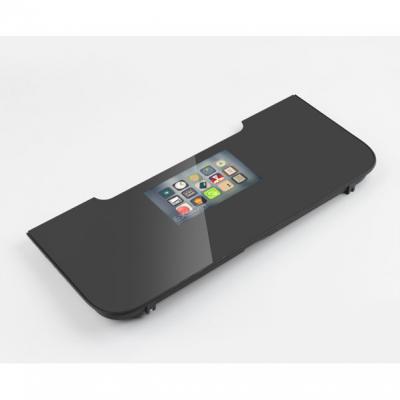OLED is one of the hottest concepts in the current display industry, and OLED itself has many advantages. For another concept in the real industry - TFT, perhaps not so many people know about it. Today EXSON, an LCD display module manufacturer, will introduce the difference between OLED and TFT. Through the comparison of the two, we can enhance our understanding of the two.
TFT (Thin Film Transistor) screen is a very mainstream display device at present. Each liquid crystal pixel on the TFT display is driven by a thin film transistor integrated behind the pixel; Each independent pixel on the screen is controlled, and the TFT display has the advantages of high responsiveness, high brightness, and high contrast.
OLED (Organic Light-Emitting Diode) is an organic light-emitting diode. OLED uses a very thin coating of organic materials and a glass substrate (or flexible organic substrate). When a current passes through, these organic materials will emit light. The OLED display is driven by an electric field, and the organic semiconductor material and the light-emitting material are injected and recombined to realize light emission.
It can be known that OLED is a bigger concept than TFT, because TFT is an improved version of LCD, and screens based on OLED technology include AMOLED, Super AMOLED, ASV and so on.
The essential difference between OLED and TFT is that OLED has self-luminous characteristics and can be displayed without a backlight panel, while TFT still needs to use backlight technology.
OLED has the advantages of self-luminescence, wide viewing angle and high response speed. The response speed of LCD will be greatly reduced at low temperature, while the operating temperature range of OLED can be between -40°C and 85°C, which is less affected by temperature and has better adaptability.
In terms of technology, the technology of OLED devices is easier than that of LCDs. In addition, OLEDs are self-illuminating, do not require backlight modules and color filters, and also eliminate the liquid crystal perfusion process of general LCD TFT display panel. Therefore, in addition to reducing material costs, The weight of the display can also be significantly reduced. Since OLED can simplify the panel structure, the light utilization efficiency is also higher.
OLED has many characteristics, such as light and thin, low energy consumption, high brightness, good luminous rate, and can be bent. The OLED screen has a wide viewing angle, high brightness, and bright colors. Many high-end mobile phones now use OLED screens.
The response time of TFT is faster than that of OLED; and the life of TFT screen is much longer than that of OLED screen. In theory, the life of OLCD screen is about 5000 times; while the life of TFT screen is about 20000 times.
OLED screens can display images by relying on their own characteristics to emit light, do not need a backlight source, and are not affected by ambient light; OLED true color screens are superior to TFT screens in terms of backlighting and brightness. Moreover, OLED screens are relatively more power-efficient.
TFT screens are active-matrix liquid crystals that need the brightness of the backlight to display images. TFT screens are affected by ambient light; therefore, TFT screens consume more power.
When the overall specifications of OLED technology are standardized and the industry chain is mature, the LCD display module prices of portable products that are extremely sensitive to power will be extremely competitive.
 Exploring the Dynamic Touch Panel Module Market Trends and ForecastsJanuary 25, 2024In a technologically driven world, touch panel modules have become an integral component across a range of industries. From smartphones and tablets to automotive and industrial applications, these mod...view
Exploring the Dynamic Touch Panel Module Market Trends and ForecastsJanuary 25, 2024In a technologically driven world, touch panel modules have become an integral component across a range of industries. From smartphones and tablets to automotive and industrial applications, these mod...view Touch Screen Monitor Maintenance MethodDecember 29, 2021In today's rapid development of technology, professional touch screen monitors provide great convenience for our work and life, but also make people more and more inseparable from it. Now the cost...view
Touch Screen Monitor Maintenance MethodDecember 29, 2021In today's rapid development of technology, professional touch screen monitors provide great convenience for our work and life, but also make people more and more inseparable from it. Now the cost...view Analysis of the Causes of Chromatic Aberration in TFT LCDOctober 27, 2020Some customers will ask us why there is a chromatic aberration in the same TFT LCD screen? The so-called chromatic aberration of a TFT LCD screen means that when two LCDs of the same model are placed ...view
Analysis of the Causes of Chromatic Aberration in TFT LCDOctober 27, 2020Some customers will ask us why there is a chromatic aberration in the same TFT LCD screen? The so-called chromatic aberration of a TFT LCD screen means that when two LCDs of the same model are placed ...view Exploring the Technology Behind Medical LCD DisplaysJanuary 25, 2024The advancements in medical technology have significantly transformed healthcare systems, with medical LCD displays playing a crucial role in enhancing patient care. These display panels are specially...view
Exploring the Technology Behind Medical LCD DisplaysJanuary 25, 2024The advancements in medical technology have significantly transformed healthcare systems, with medical LCD displays playing a crucial role in enhancing patient care. These display panels are specially...view How Should the Liquid Crystal Panel Be Maintained Best?September 26, 2022With the popularization of LCD TVs, notebook computers, LCD monitors and other liquid crystal panels, the cleaning of liquid crystal panels has also become the focus of users' attention. Many user...view
How Should the Liquid Crystal Panel Be Maintained Best?September 26, 2022With the popularization of LCD TVs, notebook computers, LCD monitors and other liquid crystal panels, the cleaning of liquid crystal panels has also become the focus of users' attention. Many user...view Enhancing Your Drive: The Power of Car LCD ModulesOctober 23, 2023In today's technology-driven world, our cars are becoming more than just a means of transportation. They are evolving into sophisticated hubs of connectivity, entertainment, and information. One o...view
Enhancing Your Drive: The Power of Car LCD ModulesOctober 23, 2023In today's technology-driven world, our cars are becoming more than just a means of transportation. They are evolving into sophisticated hubs of connectivity, entertainment, and information. One o...view Call us on:
Call us on:  Email Us:
Email Us:  2F-M1 XiaWei Industrial Park, GuanLan, LongHua District, SZ, China
2F-M1 XiaWei Industrial Park, GuanLan, LongHua District, SZ, China